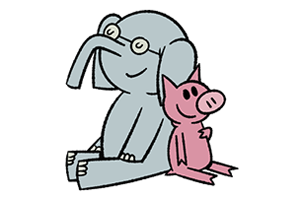 When Mo Willems announced that his Elephant and Piggie series, first published in 2007, would be coming to an end this year with the publication of the 25th book, The Thank You Book, a universal cry of despair came from the fans. And, really, who isn’t a fan of Elephant and Piggie? Teachers, librarians, parents, and especially kids love the adventures of best friends Elephant Gerald and Piggie.
When Mo Willems announced that his Elephant and Piggie series, first published in 2007, would be coming to an end this year with the publication of the 25th book, The Thank You Book, a universal cry of despair came from the fans. And, really, who isn’t a fan of Elephant and Piggie? Teachers, librarians, parents, and especially kids love the adventures of best friends Elephant Gerald and Piggie.
These award-winning bestsellers, told almost entirely through conversation, empower kids to read on their own with their simple text (made up of many sight words and printed in large, easy to read font) and encourage understanding of dialogue and engagement with text. They are also funny and a delight to read. It’s not uncommon for every single copy to be checked out of my library, and we have three or four copies of each title. Elephant and Piggie is the rare series where 25 titles just doesn’t feel like enough.
So what now? Disney and Mo Willems have created the Elephant and Piggie Like Reading! series, which launched with The Cookie Fiasco by Dan Santat and We Are Growing! by Laurie Keller. These are both delightful books have Gerald and Piggie not only introducing the texts but also talking about them afterwards—sure to make fans happy.
But my readers always want more, so I had to create a list of other series for fans of Elephant and Piggie. I chose these because the books feature best friends who sometimes clash, lots of dialogue, and a tongue-in-cheek sense of humor that encourages kids to interact with the text even if it’s through giggling.
Ballet Cat and the Totally Secret Secret. Bob Shea. 2015. Disney-Hyperion Books.
Ballet Cat only wants to talk about and play ballet. It’s her favorite. But her best friend Sparkles the Unicorn isn’t so sure. These best friends, one just a little more enthusiastic than the other, will remind readers of the loving interplay between Gerald and Piggie. (Followed by Ballet Cat: Dance! Dance! Underpants!)
Clara and Clem Take A Ride. Ethan Long. 2012. Penguin.
Clara and Clem use their imaginations to have a fanciful adventure with a car built out of blocks. Who knows where they’ll end up? Clara is like Piggie, determined to pull her more staid friend Clem into her imaginative world. (Followed by Clara and Clem in Outer Space and Clara and Clem Under the Sea.)
Okay, Andy! Maxwell Eaton. 2014. Blue Apple Books.
Preston, a coyote pup, is determined to be best friends with Andy, an alligator—even when Preston gets in Andy’s way. But it’s OK, sometimes Andy doesn’t mind—that much. (Followed by Andy, Also.)
Rabbit and Robot: The Sleepover. CeCe Bell. 2014. Candlewick Books.
Rabbit has planned everything for the perfect sleepover, but Robot keeps adding complications to the plan. Rabbit and Robot are just like Elephant and Piggie—opposites whose differences make them perfectly suited to sharing a friendship full of discovery and laugher. (Followed by Rabbit and Robot and Ribbit.)
Scribbles and Ink. Ethan Long. 2012. Blue Apple Books.
Scribbles and Ink are artists who don’t get along. Scribbles the Cat likes things messy, and Ink the Mouse likes things clean. Can their art styles come together to make something beautiful? These two enemies who become “best buddies” will have readers following their dialogue (and friendship) with delight. (Followed by Scribbles and Ink: The Contest and Scribbles and Ink: Out of the Box.)
Angie Manfredi is the head of Youth Services for the Los Alamos County Library System in Los Alamos, NM. She loves stories about wacky best friends and feels deeply connected with Piggie. She is dedicated to literacy, education, and every kid’s right to read what they want. You can read more of her writing at Fat Girl Reading.